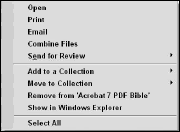Using the Files Pane
The Files pane contains a list of all files derived from the choice you made in the Categories pane. For example, click a History category, and all files viewed within the selected history timeframe appear in a list sorted by metadata that you select from the Sort by pull-down menu.
In addition to the file list you have tools at the top of the pane and context menu commands when opening a context menu on a file in the list. Beginning with the tools at the top of the pane, you find the following:
- Open. By default, the first file in the pane is selected. Click the Open tool to open the selected file. If no file is selected in the pane, the Open tool, as well as all other tools, are grayed out.
A condition where you might not have a file selected is when you click a collection that contains no file in the collection folder or when viewing a folder that contains no PDF documents. Otherwise, the first file, by default, is always selected when files are shown in the list.
- Print. Click a file in the list and click the Print tool to print the file. When you click Print, the PDF document opens and the Print dialog box opens in the foreground. Make your print attribute choices in the Print dialog box and click Print to print the file.
- Email. Select a file in the list and click the Email tool, and your default e-mail application opens with the selected file attached to a new e-mail message.
- Combine Files. Click this tool to open the Combine multiple files into one PDF file wizard. In the wizard window you can select PDF documents to combine into a single file or select a variety of different file formats that can be converted to a PDF. The tool works the same as selecting the Combine Files tool in the Tasks toolbar.
- Send for Review. Select a file in the list and choose from the pull-down menu options to Send for Shared Review or Send by Email for Review.
Below the tools is a pull-down menu used for sorting files. Files can be sorted on metadata contained within the file. From the pull-down menu you have several choices for sorting files. Sorting by Filename is the default and lists files in an alphabetical ascending order.
The Title, Subject, Author, and Keywords items are part of the Document Properties Description that you supply at the time of PDF creation from some authoring programs or that you later add in Acrobat. Creator and Producer are part of the Document Description supplied by Acrobat and relate to the original authoring program and the application producing the PDF file.
Number of Pages, File Size, and Modified Date are data that Acrobat adds to the Document Properties derived from the structure of the file. The Last Opened Date sorts the files according to the last time you viewed them in Acrobat with the most recent file listed first and in descending order.
You can also manage files from a context menu opened on a file in the list. This menu has commands to perform the same tasks handled by the tools at the top of the pane. You can see the top portion of the menu, duplicating the tools’ functions, such as Open, Print, Email, Combine Files, and Send for Review.
The Add to Collection menu item contains a submenu that lists all the collections in the Categories pane. As you add new collections to the Categories, they dynamically appear in the Add to Collection submenu. After you add a file to a collection, the context menu changes and displays a few more menu commands.
Figure below shows the Move to Collection and Remove from ‘Collection name’ commands.
The item within the single quotes denotes the collection name where a file has been added. Select Move to Collection and the submenu displays all your collection names. Select a collection and the file is moved to the collection you choose in the submenu.
Select Remove from ‘n’ (where n represents the name of a collection) and a dialog box opens prompting you to confirm the deletion. When you delete a file from a collection, the file is deleted from the collection list but is not deleted from your hard drive.
The last menu item, Show in Explorer (Windows) or Show in Finder (Macintosh) takes you to Windows Explorer (Windows) or switches to Finder view (Macintosh) and opens the folder where the file is located.
